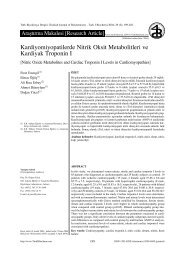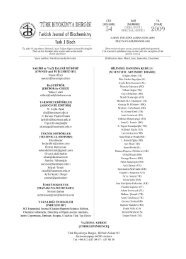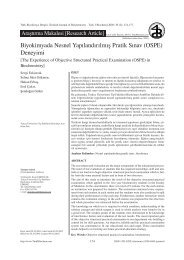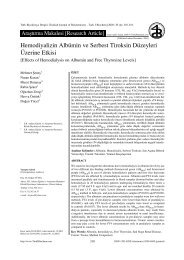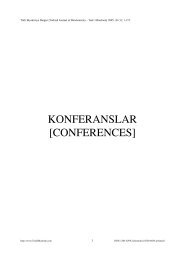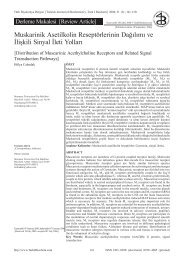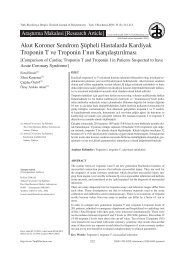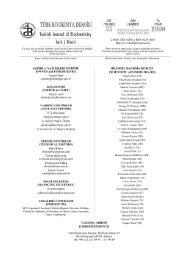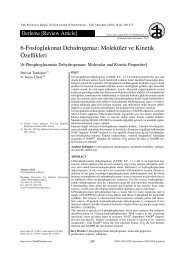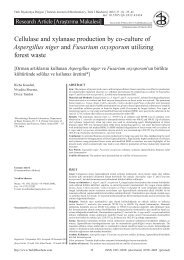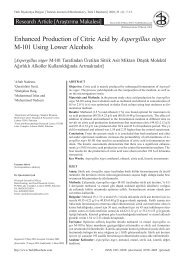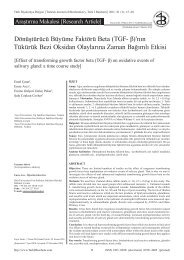24. Ulusal Biyokimya Kongresi - Türk Biyokimya Dergisi
24. Ulusal Biyokimya Kongresi - Türk Biyokimya Dergisi
24. Ulusal Biyokimya Kongresi - Türk Biyokimya Dergisi
- No tags were found...
You also want an ePaper? Increase the reach of your titles
YUMPU automatically turns print PDFs into web optimized ePapers that Google loves.
XXIV. ULUSAL B‹YOK‹MYA KONGRES‹<br />
25 - 28 Eylül 2012<br />
Dedeman Otel - Konya<br />
<strong>24.</strong> <strong>Ulusal</strong> <strong>Biyokimya</strong> <strong>Kongresi</strong>, Konya [24 th National Biochemistry Congress, Konya / TURKEY]<br />
İÇİNDEKİLER<br />
P222 - YENİ BİR PALADYUM (II) KOMPLEKSİNE YANIT<br />
OLARAK GÖĞÜS KANSERİ HÜCRELERİNDE MEYDANA GELEN<br />
MOLEKÜLER DEĞİŞİKLİKLERE PROTEOMİK YAKLAŞIM<br />
1<br />
ZELAL ADIGÜZEL, 1 TARIK BAYKAL, 1 MÜGE SERHATLI,<br />
1<br />
ÖMER KAÇAR, 2 VEYSEL YILMAZ, 3 ENGİN ULUKAYA<br />
P222 - THE MOLECULAR CHANGES İN RESPONSE TO A NOVEL<br />
PALLADİUM (II) COMPLEX İN BREAST CANCER CELLS: A<br />
PROTEOMİC APPROACH<br />
1<br />
ZELAL ADIGÜZEL, 1 TARIK BAYKAL, 1 MÜGE SERHATLI,<br />
1<br />
ÖMER KAÇAR, 2 VEYSEL YILMAZ, 3 ENGİN ULUKAYA<br />
CONTENTS<br />
1<br />
Zelal Adiguzel, 1 Tarik Baykal, 1 Muge Serhatli, 1 Omer Kacar, 3 Veysel Yilmaz,<br />
Engin 2 Ulukaya, 1 Ceyda Acilan<br />
1<br />
TÜBİTAK, Marmara Araştırma Merkezi, Genetik Mühendisliği ve Biyoteknoloji<br />
Enstitüsü, 41470, Gebze, Kocaeli / Türkiye<br />
2<br />
Uludağ,Üniversitesi Tıp Fakültesi,Tıbbi <strong>Biyokimya</strong> Bölümü, Bursa, Türkiye<br />
3<br />
Uludağ,Üniversitesi, Fen ve Sanat Fakültesi, Kimya Bölümü, Bursa, Türkiye<br />
Kanser yaygın bir sağlık problemidir ve kanser vakası sayısı her geçen gün<br />
artmaktadır. Kansere karşı savaşta kemoterapi, geniş kullanım alanı bulan ve çeşitli<br />
kanserlerin tedavisinde kullanılan etkili bir terapi yöntemidir. Kemoterapötik ajanlar<br />
arasında, metal bazlı ilaçlar sadece kanser patolojisinde etkili olmakla kalmayıp,<br />
aynı zamanda diğer antineoplastik ajanlarla birlikte kullanımda da etkili sonuçlar<br />
vermektedir. Yeni kemoterapik ilaç araştırmalarında, yeni bir molekül olan [Pd(sac)<br />
(terpy)](sac)•4H(2)O (sac = saccharinate, and terpy = 2,2\’:6\’,2\’\’-terpyridine)<br />
yakın geçmişte karakterize edilmiş olup ve meme kanserine karşı etkili bir ajan<br />
olduğu görülmüştür. Bu çalışmada, bu molekülün sitotoksik etkisi; melanoma,<br />
meme kanseri, nöroblastoma ve serviks kanserini içeren birden çok kanser hücre<br />
hattında incelendi. Ayrıca hücre ölüm mekanizmasının büyük oranda apoptotik<br />
yolaklar dolayısı ile olduğu, canlı hücre mikroskopisinde hücre küçülmesi,<br />
membran bleblenmesi ve floresan mikroskopisinde DNA kondensasyonu ve<br />
fragmentasyonu ile gösterildi. Bu ajana cevap nedeniyle meydana gelen moleküler<br />
değişiklikleri anlamak amacı ile meme kanseri hücrelerinde nano LC-MS/MS<br />
analizi yapıldı. Sonuçlarımıza göre, bu ilacın kullanımından sonra birçok yolağın<br />
etkilendiği ve enerji metabolizması, protein katlanması, hücredışı matriks, mRNA<br />
ve DNA’ya bağlanan proteinleri kapsayan 140tan fazla anlatımı değişen protein<br />
olduğu gösterildi. Ayrıca bu proteinler arasında nasıl bir iletişim olduğunu<br />
anlamak amacıyla “Hüner yolak analizi” (Ingenuity pathway analysis) yapıldı.<br />
Bu çalışma kapsamında, yapılan analizin detayları ve anlamlılığı tartışılacaktır.<br />
1<br />
GENETİC ENGİNEERİNG AND BİOTECHNOLOGY INSTITUTE, TUBİTAK<br />
MARMARA RESEARCH CENTER, KOCAELİ<br />
2<br />
ARTS AND SCİENCES, ULUDAG UNIVERSITY, BURSA<br />
3<br />
MEDICAL BIOCHEMISTRY, ULUDAG UNIVERSITY, BURSA<br />
The molecular changes in response to a novel palladium (II) complex in breast cancer cells:<br />
A proteomic approach Zelal Adiguzel1, Tarik Baykal1, Muge Serhatli1, Omer Kacar1,<br />
Veysel Yilmaz3, Engin Ulukaya2, Ceyda Acilan1 1TÜBİTAK, Marmara Research<br />
Center, Genetic Engineering and Biotechnology Institute, 41470, Gebze, Kocaeli / Turkey<br />
2Uludag University, Medical School, Department of Medical Biochemistry, Bursa, Turkey<br />
3Uludag University, Faculty of Arts and Sciences, Department of Chemistry, Bursa, Turkey<br />
Cancer is a major health problem and the number of cases has been increasing every day.<br />
In the fight against cancer, chemotherapy is a widely used and an effective method during<br />
the treatment of several types of cancer. Among the chemotherapeutic agents, metal-based<br />
drugs have been effective both in cancer pathology alone and in combination with other<br />
antineoplastic agents. In the search of new chemotherapeutic drugs, a novel molecule,<br />
[Pd(sac)(terpy)](sac)•4H(2)O (sac = saccharinate, and terpy = 2,2\’:6\’,2\’\’-terpyridine),<br />
has been recently investigated and shown to have efficient anticancer effects on breast<br />
cancer cells. In this study, we further investigated the cytotoxicity of this molecule in other<br />
types of cancer including melanomas, breast cancers, neuroblastoma and servix cancer. We<br />
also confirmed that the mean of cell death is mainly through apoptosis via morphological<br />
analyses such as cellular shrinkage, membrane blebbing by live cell imaging and DNA<br />
condensation and fragmentation using fluorescence microscopy. In order to understand<br />
the molecular changes in response to this novel agent with anticancer properties, we<br />
performed a nano LC-MS/MS analyses in human breast cancer cells, MDA-231. Our<br />
results indicated that many pathways were downregulated and identified more than 140<br />
proteins that are differentially expressed after drug treatment including proteins involved<br />
in the energy metabolism, protein folding, extracellular matrix mRNA and DNA binding<br />
proteins. We also performed ingenuity pathway analysis to understand the networking<br />
between these proteins and other pathways. The details of this analysis and the significance<br />
will be discussed during the scope of this work.<br />
Turk J Biochem, 2012; 37 (S1)<br />
http://www.TurkJBiochem.com



